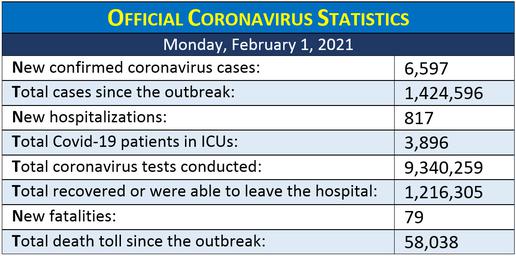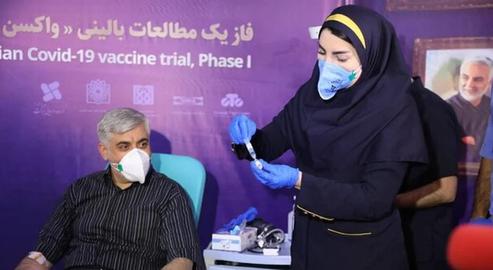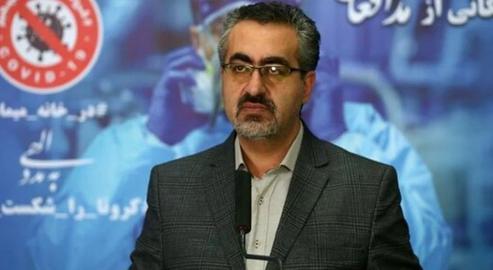Widespread vaccination against Covid-19 in Iran will get under way sometime after February 19, it has been declared.
On February 1, Mostafa Ghanei, chairman of the National Coronavirus Taskforce’s Scientific Committee, announced the government’s formal vaccination plan. Iran, he said, is to import more than 25 million doses of vaccine from abroad, on top of the around 16 million doses procured through the World Health Organization’s COVAX facility. Vaccination of the general population, he said, would start after February 19.
Ghanei confirmed that health workers and medical staff will be prioritized first, alongside the elderly, the disabled and war veterans. The in spring and early summer, people aged over 65, those aged between 16 and 64 suffering from underlying diseases, and those in regular contact with other people for work reasons will be next.
In “the second month of summer”, Ghanei added, vaccination would get under way in crowded, over-developed neighborhoods and areas of high transmission. People aged 55 to 65 who do not suffer from underlying diseases would be next to receive the jab, as well as non-frontline medical staff. Phase four of the plan, not due to get under way before winter, will see all other Iranians vaccinated.
Before any of this, Iran is shortly due to receive the first shipment of the Russian Sputnik V vaccine, which has been earmarked for high-risk groups. Criticism of this decision has been widespread, and Health Minister Saeed Namaki attempted to counter the criticism this week by saying the families of the health officials would be the first to be injected with the Russian product – although this did not form part of Ghanei’s plan.
Whatever “Is Not American or British”
According to Kianoush Jahanpour, spokesman for the Iranian Food and Drug Administration, the only important factor in deciding which vaccines to import is that they do not come from the US or the UK. He opted not to remind the public that the for this was an ideologically-driven ban imposed by the Supreme Leader.
“The procurement and importation of any vaccine would happen after a emergency or temporary permit by the Food and Drug Administration is issued,” said Jahanpour. “With the approval of this organization, vaccines that do not originate from the US or Britain can then be purchased and imported.”
Jahanpour emphasized that the Russian vaccine Sputnik-V has been approved by the Food and Drug Administration and 14 other countries. He added that it also initiates wider “cooperation” between the two countries in biotechnology.
The first shipment of Sputnik-V vaccines is scheduled to arrive in Iran by Thursday, February 4 and will be followed by others in the coming two months. Today, once again, Health Minister Saeed Namaki tried to defend the government’s decision to import the Russian vaccine. “Our own families will be the first to be inoculated with the approved imported vaccines,” he said. “It is necessary to procure foreign vaccines for vulnerable groups as long as domestically-developed vaccines cannot meet our needs.”
However, said Namaki, only approved vaccines will be imported. “We did not allow the clinical testing of vaccines produced by other countries to be conducted on our people,” he said. “No vaccine should be imported into the country before undergoing phase three of clinical tests and being [publicly] used in the country of origin. We will only import vaccines which have been purchased, registered and used by at least five or six countries in the world.”
Namaki, like all other health officials to date, could not explain why American and British vaccine do not meet this criteria.
Traffic Restrictions Extended
Alireza Raeesi, spokesman for the National Coronavirus Taskforce, announced that traffic restrictions in areas on “orange” alert for coronavirus transmission have now been extended to those areas on yellow alert as well. This decision particularly affects the three northern provinces of Gilan, Mazandaran and Golestan, which are popular holiday destinations for Iranians all over the country and especially those in Tehran.
According to Raeesi, nighttime traffic curfew, from 9pm to 3am, is now in place in all cities across Iran, regardless of the alert level.
The number of coronavirus outpatients in Tehran province has doubled in some hospitals, reported Dr. Nader Tavakoli, deputy director of Tehran Coronavirus Taskforce. “This increase is the result of the hasty lifting of restrictions, of people not taking the situation seriously, of the increase in risky behavior and of a tangible decline in compliance with health protocols,” he said.
Tavakoli also criticized the premature reopening of schools and of businesses such as cinemas, theaters and swimming pools, because they “strengthen the transmission chain of the virus... and if we continue to lift restrictions there can be no doubt that a fourth wave will come.”
According to Tavakoli, the number of new Covid-19 hospitalizations in Tehran has exceeded 300 per day after falling below 200 and currently 1,840 coronavirus patients are hospitalized across the province. He reported that the number of Covid-19 infections among people below 25 has been increasing as well.
Provinces Round-up
According to the latest figures by the health ministry, 18 cities in Iran are currently in an orange state of alert Another 124 cities are on yellow alert and 306 are blue, ostensibly at the lowest risk, but still not completely free of coronavirus.
In Alborz, 55 new Covid-19 patients were hospitalized in the 24 hours leading up to February 1. The total number of coronavirus hospitalizations in the province has reached 283, reported Dr. Mohammad Fathi, president of Alborz University of Medical Sciences. And with the death of three more Covid-19 patients in the past 24 hours, the death toll in the province is now 2,670. As of now, according to Dr. Fathi, 30,362 Covid-19 patients have been hospitalized in Alborz and 27,408 have been released from hospitals after a full or partial recovery.
Due to number of holiday travelers escaping the cold in the northern provinces, the situation in Hormozgan is relatively unstable again. With the death of two more confirmed Covid-19 patients, the official death toll in the province has reached 1,001, reported Dr. Fatemeh Noroozian, spokeswoman for Hormozgan University of Medical Sciences. Currently, a total of 155 Covid-19 patients are hospitalized across Hormozgan and, of these, 39 are in intensive care units. The more alarming news, according to Dr. Noroozian, is that number of coronavirus outpatients has increased by 20 percent compared to recent weeks.
Most of the travelers are flocking to Qeshm, Iran’s biggest island, known for its beaches, forests, valleys, caves and wildlife. From now on, Dr. Noroozian announced, traveling to any of the islands off the coast of Hormozgan is contingent on a negative coronavirus test. If a traveler tests positive, they and their companions must either return to their province of origin or go into quarantine at a cost of 200,000 tomans ($49) per person per day.
In North Khorasan, the number of Covid-19 patients is again on the rise, reported Dr. Ahmad Hashemi, President of North Khorasan University of Medical Sciences. Currently 146 Covid-19 patients are hospitalized across the province and, according to Dr. Hashemi, the daily number of hospitalizations that had fallen to 15 after recent restrictions and lockdowns has now risen to 30. The number of fatalities has also risen to an average of two per day.
A new wave of coronavirus in Fars is posing an imminent danger to the public, warned Dr. Rasoul Hemmati, president of Shiraz University of Medical Sciences. He also asked people to comply with health protocols and avoid unnecessary travel. Currently 539 Covid-19 patients are hospitalized across the province, 95 of them in ICUs, and, with the death of six more patients, the officially-recorded death toll in Fars has reached 3,147.
With a recent 27 percent increase in the number of infections in Khuzestan, it is likely that hospitals in the province will get overcrowded in the coming days, warned Dr. Farhad Abolnejadian, president of Ahvaz Jondishapur University of Medical Sciences. The message is clear, he said: “Congested parks, markets and roads lead to congested hospitals.”
Compliance with health protocols in Yazd has fallen from 74 percent last week to 69 percent, warned Dr. Ebrahim Soleimani, spokesman for Yazd University of Medical Sciences. In the past 24 hours, he reported, 50 new Covid-19 patients were hospitalized and one more patient died. Currently, 171 Covid-19 patients are hospitalized across the province, 59 of them in ICUs.
Iran’s Latest Coronavirus Statistics
In her daily briefing for February 1, health ministry spokeswoman Dr. Sima Sadat Lari announced the official coronavirus statistics for the past 24 hours:

visit the accountability section
In this section of Iran Wire, you can contact the officials and launch your campaign for various problems



























comments